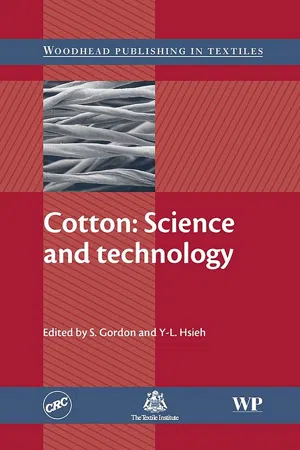1.2 Chemistry
1.2.1 Chemical composition
Cotton fibers are composed of mostly α-cellulose (88.0–96.5%) (Goldwaith and Guthrie, 1954). The noncellulosics are located either on the outer layers (cuticle and primary cell wall) or inside the lumens of the fibers whereas the secondary cell wall is purely cellulose. The specific chemical compositions of cotton fibers vary by their varieties, growing environments (soil, water, temperature, pest, etc.) and maturity. The noncellulosics include proteins (1.0–1.9%), waxes (0.4–1.2%), pectins (0.4–1.2%), inorganics (0.7–1.6%), and other (0.5–8.0%) substances. In less developed or immature fibers, the non-cellulosic contents are much higher.
The primary cell walls of cotton fibers contain less than 30% cellulose, noncellulosic polymers, neutral sugars, uronic acid, and various proteins (Huwyler et al., 1979; Meinert and Delmer, 1977). The cellulose in the primary cell walls has lower molecular weight, with the degree of polymerization (DP) between 2,000 and 6,000 and their distributions are broader (Goring and Timell, 1962; Hessler et al., 1948). The secondary wall of the cotton fiber is nearly 100% cellulose. The DP of the cellulose in the secondary wall is about 14,000, and the molecular weight distribution is more uniform (Figini, 1982). The high molecular weight cellulose characteristic of mature cotton has been detected in fibers as young as eight days old. In the later stage of elongation or 10–18 days following initiation, the higher molecular weight cellulose decreases while the lower-molecular weight cell wall components increase, possibly from hydrolysis (Timpa and Triplett, 1993). Between the ages of 30 and 45 days, the DPs estimated from intrinsic viscosities of fibers have been shown to remain constant (Nelson and Mares, 1965).
Of the non-cellulosic components in the cotton fibers, the waxes and pectins are most responsible for the hydrophobicity or low water wettability of raw cotton fibers. The term ‘cotton waxes’ has been used to encompass all lipid compounds found on cotton fiber surfaces including waxes, fats, and resins (Freytag and Donze, 1983). True waxes are esters, including gossypyl carnaubate, gossypyl gossypate, and montanyl montanate. Alcohols and higher fatty acids, hydrocarbons, aldehydes, glycerides, sterols, acyl components, resins, cutin, and suberin are also found in the wax portion of the cuticle in varying quantities. Pectins are composed primarily of poly(β-1,4-polygalacturonic acid) and rhamose to make up the rhamnogalacturonan backbone (Heredia et al., 1993). The side chains are composed of arabinose, galactose, 2-O-methylfucose, 2-O-methylxylose and apiose. Eighty-five percent of the polygalacturonic acid groups are methylated leading to a highly hydrophobic substance. Proteins are located primarily in the lumen, but small amounts of hydroxyproline rich proteins are present on the fiber surface (Darvill et al., 1980). The far lower extents of the non-cellulosics than cellulose make their detection in mature cotton fibers challenging. Extraction and reaction techniques are often employed to separate the non-cellulosic cell wall components for characterization. These procedures, however, tend to disrupt their organization and possibly alter their chemical compositions.
The amounts of the noncellulosic components change during fiber elongation and the transition from primary to secondary wall, but discrepancies remain in the exact quantities of these changes. Some of the protein constituents (enzymatic, structural or regulatory) are unique to cotton fiber cells and have been found to be developmentally regulated (Meinert and Delmer, 1977). The non-cellulosic constituents in developing cotton fibers through the onset of secondary cell wall synthesis can be clearly identified by analytical techniques, including FTIR/ATR, DSC, TGA, and pyrolysis-GC/MS methods (Hartzell-Lawson and Hsieh, 2000). The waxy compounds in developing fibers up to 17 days old are detected by their melting endotherms in the DSC. Pectins can be detected by FTIR in the 14-day-old as well as the mature fibers. FTIR/ATR measurements indicated the presence of proteins in developing fibers up to 16 dpa. The presence of proteins can be measured by FTIR/STR methods in up to 16-day-old fibers and by pyrolysis-GC/MS in up to 14-day-old fibers. On...
